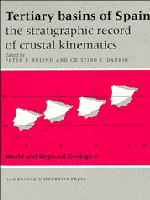Book contents
- Frontmatter
- Contents
- List of contributors
- Preface
- Dedication to Professor Oriol Riba IArderiu
- Memorial, Etienne Moissenet 1941–1994
- PART G GENERAL
- PART E EAST
- PART W WEST
- W1 The Duero Basin: a general overview
- W2 Alpine tectonic framework of south-western Duero basin
- W3 South-western Duero and Ciudad Rodrigo basins: infill and dissection of a Tertiary basin
- W4 Tectono-sedimentary evolution of the Almazán Basin, NE Spain
- W5 Tertiary basins and Alpine tectonics in the Cantabrian Mountains (NW Spain)
- W6 Lacustrine Neogene systems of the Duero Basin: evolution and controls
- W7 North-western Cainozoic record: present knowledge and the correlation problem
- W8 Onshore Cenozoic strike–slip basins in NW Spain
- W9 Tertiary of Central System basins
- PART C CENTRE
- PART S SOUTH
- Index
W9 - Tertiary of Central System basins
Published online by Cambridge University Press: 04 August 2010
- Frontmatter
- Contents
- List of contributors
- Preface
- Dedication to Professor Oriol Riba IArderiu
- Memorial, Etienne Moissenet 1941–1994
- PART G GENERAL
- PART E EAST
- PART W WEST
- W1 The Duero Basin: a general overview
- W2 Alpine tectonic framework of south-western Duero basin
- W3 South-western Duero and Ciudad Rodrigo basins: infill and dissection of a Tertiary basin
- W4 Tectono-sedimentary evolution of the Almazán Basin, NE Spain
- W5 Tertiary basins and Alpine tectonics in the Cantabrian Mountains (NW Spain)
- W6 Lacustrine Neogene systems of the Duero Basin: evolution and controls
- W7 North-western Cainozoic record: present knowledge and the correlation problem
- W8 Onshore Cenozoic strike–slip basins in NW Spain
- W9 Tertiary of Central System basins
- PART C CENTRE
- PART S SOUTH
- Index
Summary
Abstract
The rise of the Central System due to reactivation of Late Hercynian fault systems during the Alpine Orogeny directly affected the structure and stratigraphic framework of the basins nearby that were being filled at the same time. The sedimentary record is the essential key to understanding the tectonic and palaeo-morphological history of the Central Range, and vice-versa. Relating the filling of the basins with the definition of the mountain range, pre-arkosic, arkosic and post-arkosic stages have been proposed. However, it is difficult to support the previous idea that the arkosic stage continued throughout the Late Tertiary to finish in Middle Pliocene times with the deposition of the ‘Páramos (limestone)’. The arkoses of the Central System are of Eocene–Oligocene age and the highest alluvial-fan deposits may be of Aragonian age. There is only a poor record of the remaining Tertiary and Quaternary sediments, because of active river incision during this time in the basins, the ranges and elsewhere in the Spanish Meseta.
Introduction
The Central System is a complex inverse horst–graben system that developed during the Tertiary. The Plasencia fault separates two morphostructural domains: a western domain with large mountain blocks and basins oblique to the range, and an eastern one with large highs and minor basins parallel to the general structure (Fig. 1).
Western basins
The western Spanish Central System is defined by two fault families: ENE–WSW to NE–SW and NW–SE to WNW–ESE (Moreno, 1990).
- Type
- Chapter
- Information
- Tertiary Basins of SpainThe Stratigraphic Record of Crustal Kinematics, pp. 255 - 260Publisher: Cambridge University PressPrint publication year: 1996
- 1
- Cited by



